


Listen to audio highlights from this interview. 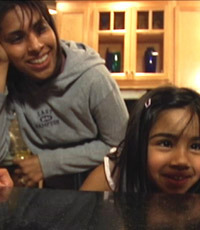
Whether or not her girls become scientists or engineers, Bhatia wants them to appreciate what scientific inquiry is all about. "It's such a wonderful gift to think about the world that way," she says, "to be curious about how things work." 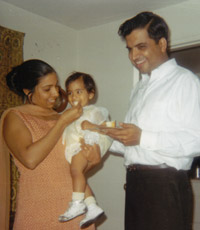
Bhatia's parents, who emigrated from India to Boston, encouraged her to see no limits in what she could achieve. Here, they celebrate her first birthday together. 
As a teen, she practiced Bharatnatyam, an intricate dance form involving the telling of Indian myths. Today, she practices yoga. "Having different things that you're really dedicated to can be a great way to get balance," she realizes. 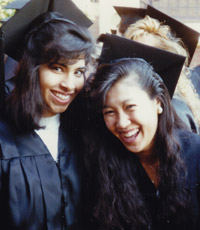
By the time Bhatia got her undergraduate degree at Brown, she knew she wanted to be a biomedical engineer. But pursuing this path, particularly as a woman, wouldn't be easy. 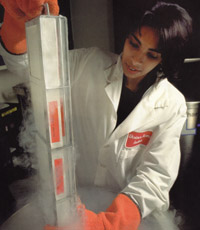
Countless failed experiments, and dogged perseverance, finally led to success in Bhatia's acclaimed Ph.D. research. 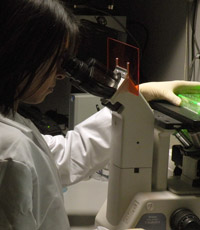
While liver cells outside the human body normally begin to die in a matter of hours, Bhatia's micro-livers remain healthy for about seven weeks, opening up many possibilities for therapies and medical research. |
If you met Sangeeta Bhatia at a playground, romping around with her two young girls, you would probably never suspect that she's a biomedical engineer, with a Ph.D. from MIT and an M.D. from Harvard. But using computer-chip technology, this down-to-earth researcher has devised an ingenious way to craft "micro-livers" in her lab, an innovation that already is helping pharmaceutical companies develop safer drugs, and that one day could lead to entire artificial organs for transplant. As this interview makes clear, Bhatia has worked hard to overcome the stereotypes and obstacles that keep some young women from becoming engineers. And she hopes to make the path a little smoother for the next generation. ENGINEERING A CAREERNOVA: Was your mom a role model for you? Sangeeta Bhatia: In some ways, yes. My mom was sort of ahead of her time. She was one of the first women MBAs in India. She was a really independent, strong woman. Both my parents' families believed that the women in their families should be educated, which at the time in India wasn't a universal idea. So she was a role model in some sense. And if I look back at it now, she arranged her life so that she could work and contribute and still be home for us at the end of the day when we came home from school. That was obviously really important for her—she made sacrifices so that could happen. But from a scientific perspective, I really didn't have a lot of role models. I didn't meet a woman who had a Ph.D. until I was 19 and I had my first summer job in college. It really struck me at the time. My boss at this biotech company was pregnant, and I had this "Aha!" moment: "Oh my gosh, my boss is a woman. And she has a Ph.D. And she has to think about having a family." So there weren't a lot of role models for women in science, and there probably still aren't that many. Q: Did you know you wanted to be an engineer when you were in high school? Bhatia: I didn't really know what engineering was in high school. I knew that I was good in math and science, and that I liked them. Often, when you're an Indian kid being brought up by Indian parents, they ask you what you're going to be when you grow up. And there are sort of three choices: "Are you going to be a doctor? Are you going to be an engineer? Or are you going to be an entrepreneur?" That was sort of my worldview at that point in my life. So when I was good in math and science, my dad [an engineer himself] said, "Oh, you should consider being an engineer." He also realized that I loved my biology class in 10th grade. And my dad had been reading—like a good, involved parent—about bioengineering and how it was this emerging field. He had a friend at MIT who was using focused ultrasound to heat up cancer, and he took me to see the lab. It really captured my imagination, that you could use machines and equipment and math and engineering for human health. It sort of all clicked for me. So when I applied to college, I looked at schools that had bioengineering programs. But I would say I still didn't really know what an engineer was until I was halfway through my engineering degree. [laughs] Q: Do most kids not know what engineers do? Bhatia: Most kids don't think about what engineering is. They don't think about all the engineering that goes into your iPod, or how planes fly. There's engineering all around us. I just don't think it's part of our dialogue with kids in high school. So one of the things I'm really interested in is forecasting for kids what engineering is, what a cool job it is. We make things that make the world better. STANDING OUTQ: Your field, tissue engineering, is something that didn't even exist a few decades ago. How did you get involved in it? Bhatia: In college, I would spend summers investigating different areas in bioengineering. Summer after summer, I would try things that really didn't click. I tried the biotech industry. I tried medical devices. Finally, my senior year, I walked by this lab [at Brown University] that said "Artificial Organs" on the door. That sounded so cool. Artificial organs! I knocked on the door and begged them to let me work there for free that summer, and they did. That lab was later renamed "Tissue Engineering," the field I'm now in. That, I think, was the pivotal moment for my career choice. Q: And then you went to graduate school. Bhatia: Yes. I had my heart set on coming to MIT for graduate school. I wanted, in particular, to go to this biomedical engineering program that Harvard Medical School runs together with MIT. I applied to this program, and I wasn't accepted my first time. But I did get into the mechanical engineering program at MIT. So I decided to come to MIT. I was hoping, once I got here, that I would show [the biomedical engineering program] that I could succeed in this environment. And that worked. Eventually they let me in, and now I'm on the faculty. Q: Were there a lot of other women engineering grad students at MIT? Bhatia: When I started MIT in the mechanical engineering department, there weren't many women. There were two in my class. I remember my first day at MIT. I wasn't sure if I was smart enough, if I was going to belong. And I was sitting in class, waiting for the lecture to start—it was a thermodynamics class—and the professor, right before class started, walked down the aisle and over to my seat, and he asked me if I was here for thermodynamics. I said yes. And he said, "Oh." And then he went back up to the front of his room and started class. I suspect that I was a surprise to him; that he wasn't used to seeing a young woman at his lecture. Q: Did that shake you up? Bhatia: Incidents like that are those little things that can make women feel uncomfortable. It's not always something overtly sexist or chauvinist, or even cruel or outrageous, that makes you feel uncomfortable. It's just those little moments when you feel conspicuous, you feel different, and you wonder if you belong. Q: How did you respond? Bhatia: I had two reactions. One was a feeling that I wanted to disappear. So I always wore pants to class and never wore too much makeup—I just wanted to be one of the gang. The other thing was, I really wanted to do well. I really wanted to show them that I did belong. So I studied like crazy and got the highest grade in the class. Now I don't try so hard to be invisible. I try just to be me. HAPPY CELLS, HAPPY PEOPLEQ: You've pioneered a way to create "micro-livers" that can live outside the human body. What normally happens to liver cells outside the body? Bhatia: Normally, when you take liver cells out of the body and you put them on a dish, they lose all their functions. They're not "happy" in that environment, because you've taken them out of the body, where they've gotten lots of signals that keep them happy. So the goal of my Ph.D. was to think about how to surround them with neighbors that would make them happier—to sort of give them a better community—and to figure out how that needed to be organized so that they would function best. Q: So you found a way to organize your cells, to create these communities, using the same technology used to etch computer chips. Was this a really innovative idea? Bhatia: I would say so. No one had ever thought about using micro-fabrication to study how tissues are organized—how cells communicate with each other, how geometry or architecture is important for tissue function. And that's in spite of the fact that we know, in the body, it's really important how your tissues are organized. But in cell culture, no one had ever found a way to control their organization. Micro-fabrication was this great tool to do it, and people have since gone on to do it in many other tissue types. Q: Do you see an analogy between how cells thrive—supported by others in a community—and how you thrive personally? Bhatia: Sure. What we do for the liver cells is we give them the right community. It's not just enough that they have each other, but they also have to have other neighbors that are unlike themselves, and they sort of function together in this community, and that's how they thrive. Developmental biologists call it the "community effect." I think about my life that way, too. I don't want to be the solitary scientist—although that's a way to do science—so I've built a community around myself, so that I can participate in this profession and thrive. TINY LIVERS, BIG IMPACTQ: One big goal in your lab is to create devices that can help people with liver disease who are waiting for liver transplants. Why is this needed? Bhatia: For most other organs we have some sort of stopgap measure. If your heart is failing, and you can't yet get a transplant, we have a pump. And if your kidney is failing, and you can't get a transplant, we have a filter. In the case of the liver, there's nothing. If your liver is failing, all you can do is wait for a donor organ to become available. And patients die every year on that wait list. So one goal of our research is to come up with an alternative to transplantation. Or, at the very least, a bridge to transplantation, something to keep those patients alive until an organ can become available—or until the liver can grow back, because it's one of the only organs that can actually grow back. Q: Can you imagine creating an entire liver to use as a transplant? Bhatia: It's sort of a 20- to 30-year big goal, to build an implantable liver, an off-the-shelf liver that you could take out of an icebox and implant into a patient. Q: How can your micro-livers be used in research? Bhatia: There are a lot of research applications: studying diseases of the liver, and drugs that damage the liver, and organisms that infect the liver. These are things that we don't know much about, because you can't study them in dying liver cells. All of a sudden now, we can study them in this model system. Q: Why has it been hard for pharmaceutical companies to know how drugs they are developing will affect the liver? Bhatia: When pharmaceutical companies make new drugs, they're required by the FDA to do animal testing to make sure that the drugs will be safe and effective. About 50 percent of the time, when they get into patients, it turns out that there was toxicity, liver damage, that couldn't have been predicted by experiments in the lab. That's probably because the human liver and the animal liver are very different. So our hope is, now that we have human livers in the lab, that we can get a window into how safe and effective drugs will be in patients much earlier in the development process. Q: Your lab has gotten funding from the Gates Foundation for work on malaria. Why have attempts to eradicate malaria failed? Bhatia: There have been big government initiatives where they sprayed all the mosquitoes and treated the whole population with anti-malarial medications. But malaria can hibernate in your liver, and it can reemerge for reasons we don't understand and then reinfect patients and reinfect the mosquitoes. So we need to better understand this hibernating form of malaria. Our hope is that we'll have these human livers, and we'll be able to grow these human malarias all the way up to the hibernating stage. And we'll be able to develop drugs against the hibernating stage as well as understand what makes them reactivate. Q: And possibly develop a malaria vaccine? Bhatia: Yes. That's the hope. "GEE WHIZ!" INSPIRATIONQ: What is Keys to Empowering Youth? Bhatia: Keys to Empowering Youth is an outreach organization that I helped to start, when I was in graduate school, with a few women friends of mine who were fellow engineers here at MIT. We were struck by, really, two things. One was the paucity of women—the lack of women colleagues that we had. The second was that we had access to the coolest technology. Our labs were just full of amazing, gee-whiz toys and gadgets and lasers—every kind of science fiction dream. So we got it in our heads that it would be great to bring kids to the MIT campus and show them these things. And over the course of the day, in these Saturday workshops, they would also get to see tens of women who were training to be engineers and scientists. So they would simultaneously see role models—become aware of this as a career path—and just be wowed by the coolness of science. Q: How old are the girls in the program? Bhatia: The age range that we chose was 11 to 13 years old, because that was the age that had been identified as the moment that girls lose interest in math and science. Q: When did you start the program, and are you still involved? Bhatia: It started in 1993, and it's still going. And now my lab serves as one of the host labs. We have a tissue engineering lab, where they touch artificial organs, like skin and cartilage, and they visualize their own cells, swabbed from their cheeks, in the microscope, and they print out colored pictures, and they get to take them home to their parents. Lately we've been doing, like, a CSI-style lab that has spies and prototypes and nano-particles and microfluidics—all of these little gadgets are part of the game. They get inundated with the technology without really knowing the high-level features of it, but just sort of that "gee whiz!" feeling. Q: Is it fun for you to see these girls get excited about science? Bhatia: When I see those kids in the lab, it's really heartwarming. It's amazing, when you're an engineer and only one out of ten of your colleagues is a woman, to see your lab full of 11-year-old girls who think this stuff is really great. And to think that, over the course of the day, they're seeing tens of girls who are in college, who are studying engineering. They're having conversations about what engineers do and what one has to take in school to pick this career path. It's sort of a great gift. |
"Most kids don't think about what engineering is. We make things that make the world better." "I walked by this lab that said 'Artificial Organs' on the door. That sounded so cool. Artificial organs!" "It's sort of a 20- to 30-year big goal, to build an implantable liver, an off-the-shelf liver that you could implant into a patient." "It's amazing, when you're an engineer and only one out of ten of your colleagues is a woman, to see your lab full of 11-year-old girls who think this stuff is really great." |
|||||||||
|
Interview conducted in March 2009 by Josh Seftel, producer of "Profile: Sangeeta Bhatia," and edited by Susan K. Lewis, senior editor of NOVA Online |
|||||||||||
|
© | Created June 2009 |
|||||||||||
